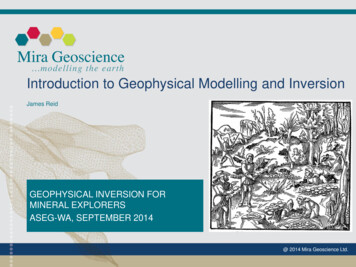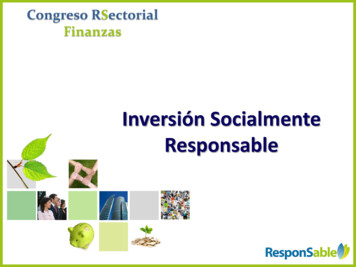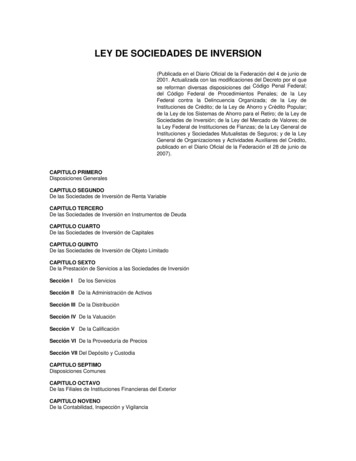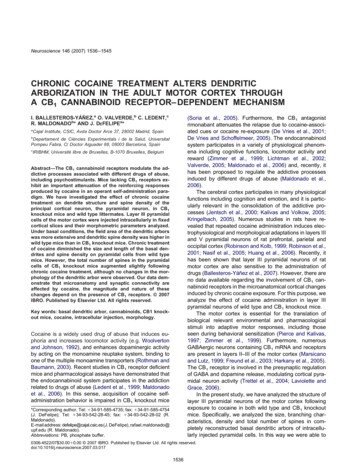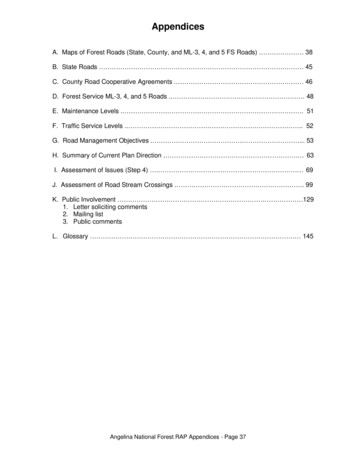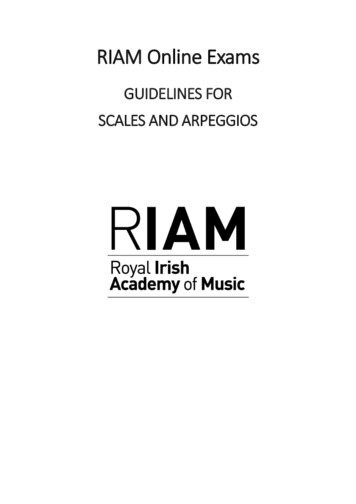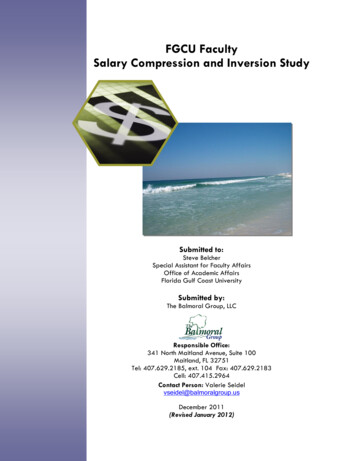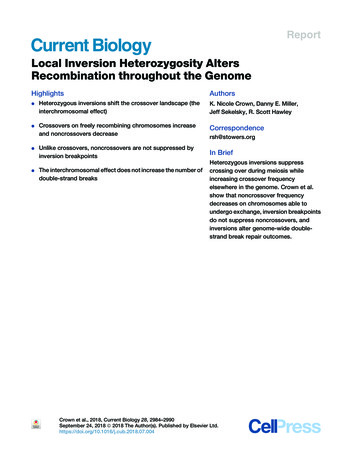
Transcription
ReportLocal Inversion Heterozygosity AltersRecombination throughout the GenomeHighlightsAuthorsdHeterozygous inversions shift the crossover landscape (theinterchromosomal effect)K. Nicole Crown, Danny E. Miller,Jeff Sekelsky, R. Scott HawleydCrossovers on freely recombining chromosomes increaseand noncrossovers decreaseCorrespondencedUnlike crossovers, noncrossovers are not suppressed byinversion breakpointsIn BriefdThe interchromosomal effect does not increase the number ofdouble-strand breaksrsh@stowers.orgHeterozygous inversions suppresscrossing over during meiosis whileincreasing crossover frequencyelsewhere in the genome. Crown et al.show that noncrossover frequencydecreases on chromosomes able toundergo exchange, inversion breakpointsdo not suppress noncrossovers, andinversions alter genome-wide doublestrand break repair outcomes.Crown et al., 2018, Current Biology 28, 2984–2990September 24, 2018 ª 2018 The Author(s). Published by Elsevier Ltd.https://doi.org/10.1016/j.cub.2018.07.004
Current BiologyReportLocal Inversion Heterozygosity AltersRecombination throughout the GenomeK. Nicole Crown,1,2,3,6,7 Danny E. Miller,4,5,6,8 Jeff Sekelsky,1,2,3 and R. Scott Hawley4,5,9,*1IntegrativeProgram for Biological and Genome Sciences, University of North Carolina at Chapel Hill, Chapel Hill, NC, USAof Biology, University of North Carolina at Chapel Hill, Chapel Hill, NC, USA3Lineberger Comprehensive Cancer Center, University of North Carolina at Chapel Hill, Chapel Hill, NC, USA4Stowers Institute for Medical Research, Kansas City, MO, USA5MD-PhD Physician Scientist Training Program, University of Kansas Medical Center, Kansas City, KS, USA6These authors contributed equally7Present address: Department of Biology, Case Western Reserve University, Cleveland, OH, USA8Present address: Department of Pediatrics, Seattle Children’s Hospital and University of Washington, 4800 Sand Point Way NE, Seattle, WA98105, USA9Lead Contact*Correspondence: 07.0042DepartmentSUMMARYCrossovers (COs) are formed during meiosis by therepair of programmed DNA double-strand breaks(DSBs) and are required for the proper segregationof chromosomes. More DSBs are made than COs,and the remaining DSBs are repaired as noncrossovers (NCOs). The distribution of recombinationevents along a chromosome occurs in a stereotypedpattern that is shaped by CO-promoting andCO-suppressing forces, collectively referred to ascrossover patterning mechanisms. Chromosomeinversions are structural aberrations that, when heterozygous, disrupt the recombination landscape bysuppressing crossing over. In Drosophila species,the local suppression of COs by heterozygous inversions triggers an increase in crossing over on freelyrecombining chromosomes termed the interchromosomal (IC) effect [1, 2]. The molecular mechanism(s)by which heterozygous inversions suppress COs,whether noncrossover gene conversions (NCOGCs)are similarly affected, and what mediates the increase in COs in the rest of the genome remainopen questions. By sequencing whole genomesof individual offspring from mothers containingheterozygous inversions, we show that, althoughCOs are suppressed by inversions, NCOGCs occurthroughout inversions at higher than wild-type frequencies. We confirm that CO frequency increaseson the freely recombining chromosomes, yet COinterference remains intact. Intriguingly, NCOGCsdo not increase in frequency on the freely recombining chromosomes and the total number of DSBs isapproximately the same per genome. Together, ourdata show that heterozygous inversions change therecombination landscape by altering the relative proportions of COs and NCOGCs and suggest that DSBfate may be plastic until a CO assurance checkpointhas been satisfied.RESULTS AND DISCUSSIONTo understand the molecular mechanism of the interchromosomal (IC) effect, we used whole-genome sequencing to identifycrossover (CO) and noncrossover gene conversion (NCOGC)events in the presence of heterozygous, multiply inverted chromosomes in individual offspring of D. melanogaster females.This approach allowed us to examine rates of both COs andNCOGCs and to map these events within 100–1,000 nt of theirprecise breakpoints. Specifically, we generated females heterozygous for the X and 3rd chromosome balancers FM7w andTM6B, or the 2nd and 3rd chromosome balancers CyO andTM6B and sequenced their individual progeny (Figure 1A; TableS2). These balancer chromosomes are multiply inverted acrosstheir entire lengths and, with the exception of rare double COs,completely suppress COs [3–6]. We sequenced a total of 102 individuals to average depth of 583 (minimum: 363; maximum:1473), with an average SNP density of 1 SNP every 358 bp forchrX, 1 SNP every 239 bp for chr2L, and 1 SNP every 294 bpfor chr2R. This allowed us to identify a total of 146 individualCO events and 101 NCOGC events (data for individual eventsare in Figures S1 and S2 and Data S1).We first examined changes in the recombination landscape onthe un-balanced, freely recombining chromosomes. As expected, by suppressing COs on heterozygous inversions, weobserved a large increase in CO frequency on the freely recombining chromosomes as compared to when balancer chromosomes are not present (i.e., a wild-type genome). The map lengthof the X chromosome increases from 56 cM in wild-type to140 cM (p 0.001; chi-square test), and the 2nd chromosomeincreases from 104 cM in wild-type to 140 cM (p 0.02; chisquare test; Figure 1B; Table S1; Data S1). Although bothchromosomes experience statistically significant changes inCO distribution (Kolmogorov-Smirnov test; chrX p 0.05; chr2p 0.05), the X chromosome has a larger, non-uniform increasein CO frequency than chromosome 2, with disproportionately2984 Current Biology 28, 2984–2990, September 24, 2018 ª 2018 The Author(s). Published by Elsevier Ltd.This is an open access article under the CC BY-NC-ND license ).
ABCDFigure 1. Frequency and Distribution of Recombination Events on Freely Recombining Normal-Sequence Chromosomes in the Presence ofHeterozygous Inversions(A) Cross scheme showing the genotypes used in this study. Multiply inverted balancer chromosomes are depicted with hashes, and structurally linear (normalsequence) chromosomes are solid. The multiply inverted balancer chromosomes suppress COs between that pair of chromosomes and cause the interchromosomal effect during which the normal sequence chromosomes experience an increase in CO frequency. Recombination on the X chromosome was analyzedin a different genetic background than chromosome 2 because the SNP density between w1118 and Oregon-R was too low to analyze NCOGCs.(legend continued on next page)Current Biology 28, 2984–2990, September 24, 2018 2985
Table 1. Expected and Observed Frequencies of Recombination Events on Freely Recombining Chromosomes in the Presence ofHeterozygous servedExpectedObservedNCOGC25.2726.2726.28Single CO22.120232723.023Double CO2.7152.842.86Triple CO0.140.110.10Quadruple CO020000Total observed CO and NCOGC frequencies are significantly different than expected based on wild-type frequencies (p 0.05; Fisher’s exact test;both chromosomes). Expected numbers were calculated using wild-type frequencies from [7].larger increases in the centromere-proximal and subtelomericregions (Figure 1B). It is tempting to speculate that structural differences between the chromosomes cause differentstrengths in their response. Centromeric suppression of COs ismuch weaker on the X chromosome due to a large block ofheterochromatin [7, 8], potentially making it easier to increasethe CO rate in that region during the IC effect. Similarly differentdegrees of responses are also reported in the historical literatureon the IC effect [1] and have been observed in natural populations [9].COs in D. melanogaster are typically limited to an average ofone CO per chromosome arm by CO patterning mechanisms.One of these mechanisms is CO interference, which preventsCOs from occurring close to each other and ultimately resultsin a non-random distribution of COs along a chromosome [10].On the X chromosome, the increase in CO frequency results inthe recovery of significantly more double CO (DCO) chromosomes than expected (p 0.001; chi-square test), as well asseveral triple and quadruple COs (Table 1; Figure S2), which inwild-type are recovered at rates fewer than 1 in 1,000 or 1 in10,000, respectively [11]. An increase in frequency of multi-COchromosomes could indicate a loss or weakening of CO interference. We modeled CO interference by calculating the averagephysical pairwise distance between single COs in wild-typeand compared that to the observed distances between DCOs(Figure 1C; STAR Methods). For all three chromosome arms,DCO distances are significantly greater than expected bychance (p 0.001), showing that interference is still intact. Forthe X chromosome, DCO distances are not significantly differentthan distances observed in wild-type; however, for chromosome2, the observed DCO distances are shorter than in wild-type (Figure 1C), suggesting that interference may be weaker, but notabsent, during the IC effect on this chromosome. Together,these data show that interference is largely intact in the presenceof a heterozygous inversion and that chromosome arms canaccommodate more than one CO while still maintaininginterference.One possible mechanism for increasing CO frequency is tomake more double-strand breaks (DSBs). Alternatively, the number of DSBs could remain the same, but a higher proportion ofthose DSBs could be repaired as COs at the expense ofNCOGCs. We tested both of these hypotheses by examiningthe number of NCOGCs that occurred on the freely recombiningchromosomes (Figure 1D; Data S1). We found that, for bothchromosomes, we recovered significantly fewer NCOGCs thanexpected (Table 1). Additionally, using maximum-likelihood analysis, we estimate a rate of 1.4 3 10 8 NCOGCs per base pair pergeneration for the freely recombining 2nd chromosome and1.9 3 10 8 for the freely recombining X chromosome, ratesthat are approximately 65% and 89% of the wild-typegenome-wide estimate of 2.1 3 10 8 using the same method[7]. The pattern of NCOGCs for chromosomes 2L and 2R showa uniform decrease in rates across the chromosome, yet thepattern of NCOGCs for the X chromosome shows large decreases in rate for some regions and increases for others, potentially explaining why the per base pair rate of NCOGC is closer towild-type for the X chromosome. Thus, the frequency of COs onfreely recombining chromosomes increases in response to heterozygous inversions, yet there appears to be no correspondingincrease in the rate of NCOGCs.We next analyzed the relationship between COs and NCOGCson the inverted chromosomes. We identified 78 NCOGC eventsbetween the 2nd and 3rd chromosome balancers and their structurally linear homologs (Figure 2; Data S1). Using maximum-likelihood analysis, we estimate a NCOGC rate between thesemultiply inverted chromosomes and their homologs of 3.0 310 8 per base pair per generation, a rate approximately 40%higher than wild-type. These data suggest that DSBs on inversion chromosomes are preferentially repaired as NCOGCs. Wehave, however, also considered the possibility that the NCOGCrate is higher on inversion chromosomes due to preferentialrecovery of non-exchange chromosomes. Sturtevant andBeadle demonstrated that COs within paracentric inversionsdo not affect viability and are most likely segregated into polar(B) Per-arm CO frequency and distribution. Frequency is reported as cM/Mb using a 500-kb sliding window with a best-fit line. Wild-type data (blue) are from [3];data from this study are shown in green. Some, but not all, centromere-proximal heterochromatin is included in the D. melanogaster release 6 assembly and isshaded in gray. Centromeres are represented as black circles on the x axes.(C) Models of CO interference. Vertical lines represent observed distances between DCOs in wild-type (blue) and during the IC effect (green).(D) Per-arm NCOGC frequency and distribution. Frequency is reported as number of events per 1 Mb using a 500-kb sliding window with a best-fit line. Wild-typedata from [3] are in blue; data from this study are in green.See also Figure S1 and Data S1.2986 Current Biology 28, 2984–2990, September 24, 2018
ABCDFigure 2. The Frequency and Distribution of NCOGCs on Multiply Inverted Balancer Chromosomes(A) Location of NCOGCs onto the multiply inverted 2nd chromosome balancer CyO.(B) Per-arm NCOGC frequency and distribution for the multiply inverted 2nd chromosome balancer CyO. Frequency is reported as number of events per 1 Mbusing a 500 kb sliding window with a best-fit line. Some centromere-proximal heterochromatin is included in the release 6 assembly and is shaded in gray.(C) Location of NCOGCs onto the multiply inverted 3rd chromosome balancer TM6B. Heterochromatin is shaded in gray.(D) Per-arm NCOGC frequency and distribution for the multiply inverted 3rd chromosome balancer TM6B. Frequency is reported as number of events per 1 Mbusing a 500 kb sliding window with a best-fit line.See also Figure S2 and Data S1.bodies, supporting the possibility that transmission distortion isresponsible for the increase in NCOGCs in the present study[12]. However, cytological studies of the X chromosome balancer FM7 (which contains only paracentric inversions) havedemonstrated that these chromosomes are rarely linked bychiasmata at metaphase, arguing that DSBs on these chromosomes are rarely repaired as COs and that exchange is trulysuppressed [13, 14]. COs within pericentric inversions (as arefound on 2nd and 3rd chromosomal balancers) result in lethalduplications and deletions but are predicted to segregate normally. However, there are genetic data showing that pericentricinversions surprisingly do not decrease viability but rather thatthe frequency of COs within pericentric inversions is reducedto 25% of wild-type [15, 16]. Thus, balancers comprising paracentric and those comprising pericentric inversions prevent therecovery of COs primarily by reducing exchange rather thanreducing the recovery of exchanges. Therefore, although transmission distortion may be contributing to the increase inNCOGCs in the present study, we believe the effect is largelydue to preferential repair of DSBs into NCOGCs.There is mounting evidence that, in Drosophila species, inversion breakpoints suppress COs 1–3 Mb outside the breakpoint[2, 3, 5, 6, 17]; this type of suppression is mechanistically distinctfrom the transmission distortion discussed above, as it extendsoutside of the inversion. Indeed, in this study, we recovered onesingle CO and one DCO that occurred between a balancer chromosome and its structurally linear homolog, with both eventsoccurring no closer than 1.7 Mb from the nearest inversionbreakpoint (Figure S2; Data S1). It has remained unclear whetherNCOGCs are similarly suppressed near inversion breakpoints.We analyzed the distances between inversion breakpoints andNCOGCs and found that 21 NCOGCs occurred within 1 Mb ofan inversion breakpoint. Of those 21 NCOGCS, only 3 werewithin 500 kb of the breakpoints (Figure S3). Although thesedata suggest that NCOGCs may be suppressed very locallyaround inversion breakpoints, overall they are clearly lessCurrent Biology 28, 2984–2990, September 24, 2018 2987
Table 2. Calculation of Number of DSBs per Meiosis Using NCOGC and CO Rates in Wild-Type and during the Interchromosomal EffectStocks sequencedWild-TypeInterchromosomal Effect196502.10E 081.86E 08 (X chromosome); 2.95E 08 (2nd and3rd chromosomes)2.80.44 (X chromosome); 3.2 (2nd and 3rd chromosomes)11.11.76 (X chromosome DSBs); 12.9 (2nd and 3rdchromosome DSBs)NCOGCsNCOGC rateaNCOGCs per haploid meiosisbDSBs this accounts for per meiosiscCOsTotal COs observed54170 (X chromosome)DSBs this accounts for per meiosisd5.52.8Total breakse16.617.5For simplicity, data from the CyO; TM6B crosses are used to calculate number of DSBs during the IC effect (i.e., COs observed on the normal sequenceX chromosome, the NCOGC rate for the X chromosome, and the combined NCOGC rate for CyO and TM6B). The genome-wide number of COs andNCOGC rate is used for the wild-type. See also Figures 1 and 2.aNCOGC rates are maximum-likelihood estimates. See STAR Methods for a description.bCalculated by multiplying the NCOGC rate per base pair by the genome size in base pairs.cCalculated by multiplying the NCOGCs per haploid meiosis by four, as only one-quarter of NCOGCs are detected.dCalculated by multiplying the number of crossovers by two, as only one-half of CO events are observed, then dividing by the number of stockssequenced.eCalculated by adding DSBs repaired as NCOGCs and those repaired as COs.sensitive to the mechanisms that suppress CO formation 1–3 Mbaround inversion breakpoints.The most parsimonious explanation for the genome-widechanges in CO and NCOGC frequencies during the IC effect isthat the total DSB number is approximately the same as inwild-type. Cytological studies in D. melanogaster have demonstrated that 20–25 DSBs are made during female meiosis andthat this number does not increase in the presence of multiplebalancer chromosomes [18, 19]. However, the average numberof DSBs can also be estimated from our data. Using the NCOGCrate in inversions and the CO and NCOGC rates on freely recombining chromosomes, we calculate that 17.5 DSBs were madeper genome per meiosis (Table 2; this calculation corrects forthe fact that only one-quarter of the NCOGCs and one-half ofCOs are recovered in the progeny). We used the same analysison wild-type data [7] and, strikingly, calculated that 16.6 DSBsare made per genome per meiosis (Table 2). The calculatednumber of DSBs in each experiment is 10%–20% smaller thancytological estimates, potentially because of genetically invisibleevents, such as noncrossover gene restorations or intersisterrecombination. Indeed, the ability to adjust the ratio of COs toNCOGCs is reminiscent of CO homeostasis in budding yeastand mice, where if the number of DSBs is decreased, thenumber of COs is generally maintained at the expense ofNCOGCs [20, 21].Our data lead to a model where the recombination landscapein D. melanogaster responds to heterozygous inversions bymodifying the fate of DSBs, not by increasing the number ofDSBs. Furthermore, most of this shift occurs in subtelomericand centromere proximal regions, where CO control mechanisms normally favor NCOGC formation [7]. Recent evidencehas shown that the number of DSBs formed during meiosis iscontrolled using multiple feedback mechanisms. In several organisms, including D. melanogaster, there is a DSB-limiting2988 Current Biology 28, 2984–2990, September 24, 2018mechanism that shuts down DSB formation [22, 23]. In buddingyeast, there is also a feedback mechanism that increases thenumber of DSBs made in response to problems with ‘‘homologengagement’’ [24]. Although the IC effect has been comparedto problems with homolog engagement by others [24], cytological examination of phosphorylated H2AV, a marker of DSBs,and our maximum-likelihood estimates presented here suggestthat DSBs never accumulate to levels higher than wild-type[18]. Thus, a comprehensive assessment of the data suggeststhat the increase in COs during the IC effect is not due to an increase in DSB number.It is intriguing to consider how the IC effect might cause thischange in DSB fate. One current model is that chromosomeaxis discontinuities between the inversion and its homologtrigger a checkpoint that extends the time during which DSBscan be repaired as COs [1, 18]. An alternative model is that theabsence of a CO on the inverted chromosome triggers a COassurance checkpoint. Until this checkpoint is satisfied, DSBscontinue to be repaired as COs on the freely recombining chromosome. Because interference is still intact, COs in the medialpart of the chromosome arm still prevent neighboring DSBsfrom being repaired as COs, but DSBs in the subtelomeric andcentromere proximal regions are free to be repaired as COs.The latter model implies that NCOGC formation in subtelomericand centromere-proximal regions is delayed until after CO formation is complete. Existing molecular evidence supports theidea that the final decision to repair a DSB as a CO or NCOGCis made late in the DNA repair process [25]; this late decisionmay provide flexibility in response to a CO assurance checkpoint. Interestingly, in many organisms, DSB repair is requiredfor full chromosome pairing and formation of the synaptonemalcomplex (the tripartite structure formed between homologouschromosomes during meiosis) [26]. In D. melanogaster, chromosomes pair and synaptonemal complex is built before DSBs are
made [27]; therefore, DSBs most likely provide no advantageduring homology searching. Our data lead us to believe that inD. melanogaster, where DSB repair is not required for homologpairing, NCOGCs can function as a reserve of potential COs siteswhen the desired number of COs have not been formed.Recombination, and particularly crossing over, is essential forproper chromosome segregation during meiosis, but it is alsoimportant for allowing genetic exchange among individuals,which ultimately homogenizes nucleotide diversity within or between populations. Depending on their frequency in a population, inversions can act as barriers to gene flow by suppressingCOs and thus play an important role in sequestering haplotypesaway from genetic exchange. This sequestration is essential formaintaining linkage and may be particularly important in caseswhen inversions harbor blocks of co-adapted alleles, suchas supergenes [28] and meiotic drive systems [29], and is alsoa critical mode of speciation [30, 31]. Suppressing COs iseffective at slowing gene flow at the megabase scale, but therates of NCOGCs we have presented here would allow higherthan wild-type rates of gene flow on a small scale (the averageNCOGC size is 400 bp in D. melanogaster) [32]. We haveshown that NCOGCs clearly happen throughout inversions, areinsensitive to the mechanisms that suppress CO formation,and are transmitted at a rate approximately 40% higher thanwild-type. Although NCOGCs are unlikely to completely breakdown linkage disequilibrium in an inversion, they will allownew genetic information in and out of the sequestered region.Therefore, although inversions may be maintained becauseof their ability to keep haplotypes together by suppressingCOs, NCOGCs may be equally important for their persistenceby allowing frequent but small amounts of gene flow. Our baseline estimate of the transmission rate of NCOGC frequencywithin inversions suggests that NCOGCs may cause fasterhomogenization of nucleotide diversity than is accounted for incurrent models and at least necessitates a re-examination ofthose models [33].Together, our data lead to a comprehensive model of howinversions act both in cis and trans to change the global landscape of recombination in D. melanogaster. Locally, they preventDSBs from being repaired as COs but have no negative effecton NCOGCs, and globally, they cause an increase in COsand a decrease in NCOGCs on freely recombining chromosomes. Thus, the net effect of heterozygous inversions inD. melanogaster is not just local suppression of COs but agenome-wide shift in the distribution of large-scale geneticexchange. Such dramatic changes to the pattern of gene flowacross genomes will have an impact on the dynamics of population genetics and are especially important to consider whenmodeling the contributions of inversions to speciation or ecological adaptation.STAR METHODSDetailed methods are provided in the online version of this paperand include the following:dddKEY RESOURCES TABLECONTACT FOR REAGENT AND RESOURCE SHARINGEXPERIMENTAL MODEL AND SUBJECT DETAILSdddMETHOD DETAILSB DNA isolation, sequencing, genome alignment, andSNP callingB Sanger sequencing of individual NCOGCsQUANTIFICATION AND STATISTICAL ANALYSISB Identification of CO and NCOGC eventsB Calculation of CO and NCOGC ratesB Modeling of interferenceDATA AND SOFTWARE AVAILABILITYSUPPLEMENTAL INFORMATIONSupplemental Information includes three figures, three tables, and one data fileand can be found with this article online at DGMENTSWe thank Justin Blumenstiel, Mohamed Noor, Katharine Korunes, and members of the Hawley, Sekelsky, and Zanders labs for helpful comments anddiscussion; Angela Miller for help with figure preparation and editing; andmembers of the Stowers Institute Molecular Biology core for expert helpwith DNA sequencing. K.N.C. is supported by NIH grant 5K99GM118826.J.S. is supported by NIH grant 1R35GM118127. R.S.H. is supported by theStowers Institute for Medical Research. This research was funded by an awardto R.S.H. from the Stowers Institute for Medical Research and NIH grant5K99GM118826 to K.N.C. The following ORCIDs apply to the authors:0000-0002-2595-3428 (K.N.C.), 0000-0001-6096-8601 (D.E.M.), 0000-00024424-677X (J.S.), and 0000-0002-6478-0494 (R.S.H.).AUTHOR CONTRIBUTIONSK.N.C. was responsible for conceptualization, methodology, investigation,and writing. D.E.M. was responsible for conceptualization, methodology, software, investigation, and writing. J.S. and R.S.H. were responsible forconceptualization.DECLARATION OF INTERESTSThe authors declare no competing interests.Received: March 22, 2018Revised: June 6, 2018Accepted: July 2, 2018Published: August 30, 2018REFERENCES1. Lucchesi, J.C., and Suzuki, D.T. (1968). The interchromosomal control ofrecombination. Annu. Rev. Genet. 2, 53–86.2. Stevison, L.S., Hoehn, K.B., and Noor, M.A.F. (2011). Effects of inversionson within- and between-species recombination and divergence. GenomeBiol. Evol. 3, 830–841.3. Miller, D.E., Cook, K.R., Hemenway, E.A., Fang, V., Miller, A.L., Hales,K.G., and Hawley, R.S. (2018). The molecular and genetic characterizationof second chromosome balancers in Drosophila melanogaster. G3(Bethesda) 8, 1161–1171.4. Lindsley, D.L., and Zimm, G.G. (1992). The Genome of Drosophila melanogaster (Academic Press).5. Miller, D.E., Cook, K.R., Arvanitakis, A.V., and Hawley, R.S. (2016). Thirdchromosome balancer inversions disrupt protein-coding genes andinfluence distal recombination events in Drosophila melanogaster. G3(Bethesda) 6, 1959–1967.6. Miller, D.E., Cook, K.R., Yeganeh Kazemi, N., Smith, C.B., Cockrell, A.J.,Hawley, R.S., and Bergman, C.M. (2016). Rare recombination eventsCurrent Biology 28, 2984–2990, September 24, 2018 2989
generate sequence diversity among balancer chromosomes in Drosophilamelanogaster. Proc. Natl. Acad. Sci. USA 113, E1352–E1361.22. Joyce, E.F., Pedersen, M., Tiong, S., White-Brown, S.K., Paul, A.,Campbell, S.D., and McKim, K.S. (2011). Drosophila ATM and ATR havedistinct activities in the regulation of meiotic DNA damage and repair.J. Cell Biol. 195, 359–367.7. Miller, D.E., Smith, C.B., Kazemi, N.Y., Cockrell, A.J., Arvanitakas, A.V.,Blumenstiel, J.P., Jaspersen, S.L., and Hawley, R.S. (2016). Wholegenome analysis of individual meiotic events in Drosophila melanogasterreveals that noncrossover gene conversions are insensitive to interferenceand the centromere effect. Genetics 203, 159–171.23. Lange, J., Pan, J., Cole, F., Thelen, M.P., Jasin, M., and Keeney, S. (2011).ATM controls meiotic double-strand-break formation. Nature 479,237–240.8. Yamamoto, M., and Miklos, G.L.G. (1978). Genetic studies on heterochromatin in Drosophila melanogaster and their implications for the functionsof satellite DNA. Chromosoma 66, 71–98.24. Thacker, D., Mohibullah, N., Zhu, X., and Keeney, S. (2014). Homologueengagement controls meiotic DNA break number and distribution.Nature 510, 241–246.9. Hunter, C.M., Huang, W., Mackay, T.F.C., and Singh, N.D. (2016). The genetic architecture of natural variation in recombination rate in Drosophilamelanogaster. PLoS Genet. 12, e1005951.25. Crown, K.N., McMahan, S., and Sekelsky, J. (2014). Eliminating both canonical and short-patch mismatch repair in Drosophila melanogaster suggests a new meiotic recombination model. PLoS Genet. 10, e1004583.10. Lake, C.M., and Hawley, R.S. (2012). The molecular control of meioticchromosomal behavior: events in early meiotic prophase in Drosophilaoocytes. In Annual Review of Physiology, Volume 74, D. Julius, and D.E.Clapham, eds. (Annual Reviews), pp. 425–451.26. Kauppi, L., Barchi, M., Lange, J., Baudat, F., Jasin, M., and Keeney, S.(2013). Numerical constraints and feedback control of double-strandbreaks in mouse meiosis. Genes Dev. 27, 873–886.11. Weinstein, A. (1936). The theory of multiple-strand crossing over. Genetics21, 155–199.12. Sturtevant, A.H., and Beadle, G.W. (1936). The relations of inversions in theX chromosome of Drosophila melanogaster to crossing over and disjunction. Genetics 21, 554–604.13. Gong, W.J., McKim, K.S., and Hawley, R.S. (2005). All paired up with noplace to go: pairing, synapsis, and DSB formation in a balancer heterozygote. PLoS Genet. 1, e67.14. Theurkauf, W.E., and Hawley, R.S. (1992). Meiotic spindle assembly inDrosophila females: behavior of nonexchange chromosomes and the effects of mutations in the nod kinesin-like protein. J. Cell Biol. 116, 1167–1180.15. Coyne, J.A., Meyers, W., Crittenden, A.P., and Sniegowski, P. (1993). Thefertility effects of pericentric inversions in Drosophila melanogaster.Genetics 134, 487–496.27. McKim, K.S., Green-Marroquin, B.L., Sekelsky, J.J., Chin, G., Steinberg,C., Khodosh, R., and Hawley, R.S. (1998). Meiotic synapsis in the absenceof recombination. Science 279, 876–878.28. Joron, M., Frezal, L., Jones, R.T., Chamberlain, N.L., Lee, S.F., Haag, C.R.,Whibley, A., Becuwe, M., Baxter, S.W., Ferguson, L., et al. (2011).Chromosomal rearrangements maintain a polymorphic supergene controlli
Current Biology Report Local Inversion Heterozygosity Alters Recombination throughout the Genome K. Nicole Crown,1,2,3,6,7 Danny E. Miller,4,5,6,8 Jeff Sekelsky,1,2,3 and R. Scott Hawley4,5,9,* 1Integrative Program for Biological and Genome Sciences, University of North Carolina at Chapel Hill, Chapel Hill, NC, USA 2Department of Biology, University of North Carolina at Chapel Hill, Chapel .

